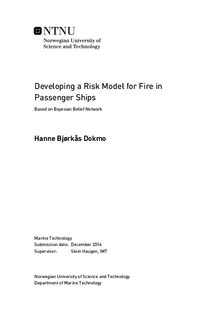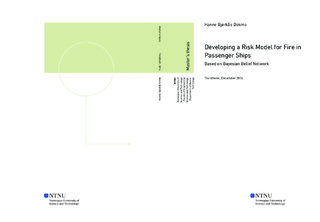| dc.description.abstract | Passenger ships, especially cruise ships, are rapidly increasing in size. With larger vessels, comes a greater risk to the passengers if something where to happen. A fire on a passenger vessel can spread quickly, and with as much as thousands of people needing to be evacuated many things could go wrong. The issue of the safety on board is therefore crucial to consider, seeing as the consequences could be tremendous. There are three types of passenger ships; Passenger vessel, RoPax vessel and cruise vessel. It was found that cruise vessels have a higher incident frequency, than the two other types. This complies well with the cruise vessels becoming bigger, and as such carrying a higher risk.
The National Risk Ship Model project aims to develop risk models for ships in Norwegian waters, based on Bayesian Belief Networks. These networks are a presentation of the causes (nodes) for an incident and the relations (arcs) between them. Such a network can be used both quantitatively and qualitatively, and is able to consider the relation between human, organisation and technology. They have also proven to be more flexible than commonly used fault trees.
Risk influencing factors and risk indicators can be used to quantify the nodes. A risk influencing factor is usually not measurable, and risk indicators are therefore used to quantify the factors. Organisational Risk Influencing Method is proposed as a possible method to quantify indicators, factors and nodes. The method is based on assigning factors with indicators for each node, which then are ranked and weighted against each other in order to give values to the node.
The Bayesian Belief Network presented in this thesis is based on already developed networks in the project, and adjusted to the current evet of fire on a passenger ship. It is chosen to divide between different areas on the ship, and focus on the ones that has proven to have the highest risk. This was found to be machinery spaces, galley, laundry, accommodation and car deck. Machinery spaces, is however not included in the network, since a network for fire in machinery spaces already has been developed. Possible factors and indicators were proposed for cabin, galley, housekeeping (laundry) and car deck, which are the second most immediate nodes. The intermediate nodes are set as collective terms for these areas, and are ignition source, flammable material and firefighting measures. Factors and indicators has also been proposed for electrical system, passive fire protection and active firefighting systems. Some of the nodes were similar to what has been presented in another thesis using the same quantification method, and for this case a summary of these findings were presented. Additional research was presented, if it was found, and the factors and indicators for the node in question was adjusted to the current case.
As for data worth mentioning it was found that the frequency for severe incidents when regarding fire on passenger ships is 4E-03 per ship-year and the expected number of incidents each year was 5.4E-01. It was also found that the four most hazardous areas stand for 84 % of the areas where a fire occurs. The most common ignition sources were found to be electrical, cigarettes, hot surface or spontaneous combustion, and they stand for 79 % of the incidents. | |

